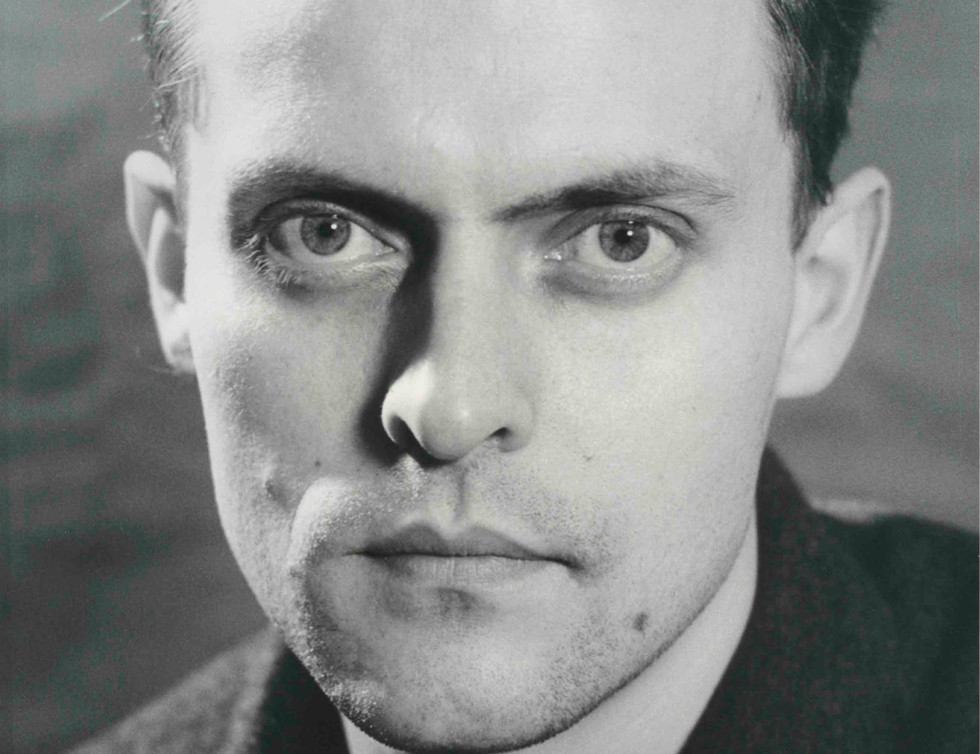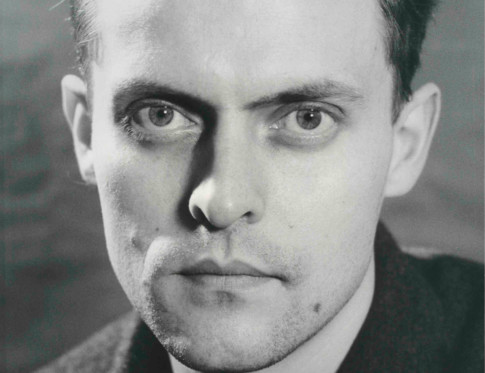
Portrait of Öyvind Fahlström. Photo: Lütfi Özkök
Image Machines
Even in Fahlström’s earliest works from the 1950s there are clear tendencies towards an approach that could be linked to the theme of mobility, issues of world view and alternative histories. He explored how individual elements could be combined in different ways and be repeated to generate new meanings. One example of this is how Fahlström dealt with language, sentences and letters as concrete material for his poetry. Another example is his paintings Ade-Ledic-Nander I and II (1955-57) where signs and abstract elements make up “character-forms” which interact with each other in a kind of societies in a way that is open and organic to the beholder.
The detailed painting Sitting… (1962) is the oldest piece. It was the first larger work Fahlström made after his arrival in New York. It has traits of the character-forms from Ade-Ledic-Nander but Fahlström also introduces figurative elements from comics and borrows the comic book structure, where frames convey time, movement and action. As in his previous works, there is no obvious way to “read” Sitting… Instead, Fahlström emphasises that there are always several, almost endless ways in which the given elements can be combined and understood in relation to one another.
Six months later, Fahlström’s experiments with these concepts led him to replace the function of the comic strip frames with movable, magnetic elements that could be repositioned over time on the pictorial surface. This method was to become essential to the later part of Fahlström’s oeuvre. Sitting… Six Months Later (1962) was Fahlström’s first so-called variable painting. Life-span No 3 (Marilyn Monroe) (1967) is a later example. The significance of this stage in his artistic career is clear when we consider that all of Fahlström’s paintings after 1962, with the exception of World Map (1972), are variable works.
In the magazine Art and Literature in 1964, the artist writes that his objective with these works is to activate the viewer, who can envision several combinations or relationships within the framework of one picture. This is a call to all and sundry to manipulate the world, as Fahlström writes in his eponymous manifesto, instead of accepting it as it is. He compares it to a game. It could also be likened to independent thinking, rather than passive consumption of information as knowledge.
The game idea is also applied in Notes (for Dr Schweitzer’s Last Mission) (1964). This work came about when Fahlström was creating his large spatial installation Dr Schweitzer’s Last Mission (1964-66). In an interview in Dagens Nyheter (1973), Fahlström relates how he considered the world to be corrupt, and that he had named his work after the missionary Albert Schweitzer because he represented antiquated, patriarchal colonialism. In Notes (for Dr Schweitzer’s Last Mission), each player controls one of four zones or power blocs (USA, Neutral, Russia, China) and has 40 words with which to infiltrate their opponents’ enemy zones, “so that the corresponding part of the password covers the largest possible number of the same letters (in the same order) in the words on the enemy zone, and also achieving the most attractive phrase”.
Notes (for Dr Schweitzer’s Last Mission) is one of the first works by Fahlström where he expressly refers to the world’s geographical territories and power blocs. This was later to become a central theme in works such as World Bank (1971), his versions of Monopoly games (nine in all made in 1970-71), and World Map (1972). Fahlström regarded World Map as a historical map from ca 1970, where the shape of the countries was defined by information rather than geography. The data in the work mainly relates to oppression, economic exploitation, freedom movements in the Third World, and the recession in the USA. The information material defining Europe consists of an excerpt from the Swedish government’s manual for diplomatic wives, or more specifically, the chapter titled “In the event of a revolution”. This presentation features the graphic version of the painting: Sketch for World Map from 1973.
The most explicit expression of the closer link between Öyvind Fahlström’s art and the world was perhaps his video work Mao-Hope March (1966), in which he not only portrays the world in the art space but directly interacts with it. What we see is a protest march organised by Fahlström in New York, with seven placards; six of them show the popular American comedian Bob Hope, and the seventh shows Mao Tse-tung. Without any further announcement, the group of protesters marched down Fifth Avenue. Assisted by radio reporter Bob Fass, Fahlström documented the reactions of those passing by to this unexpected connection. Fass also asked the people he met if they were happy. The film footage was originally included in Fahlström’s theatrical work, Kisses Sweeter than Wine (1966), but in 1973 it was presented as a work in its own right.
Curator: Fredrik Liew
Image Machines 27 February 2015–17 April 2016
Further reading
On Kisses Sweeter than Wine
Radio feature in two parts, where Öyvind Fahlström in person, like a sports commentator, reports from his own performance. This unique recording, which was previously believed to be lost, is presented for the first time since its original broadcast on Swedish Radio in January 1967. Listen to the recording
Öyvind Fahlström’s concrete poetry
Öyvind Fahlström, Bord-Dikter 1952–55, Bonniers förlag, 1966 (published in facsimile by Bokförlaget Lejd, 1999).

